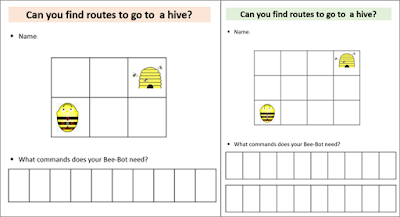Bee-Bot - Day 4 (Older Group)
2. Objectives
● To find different routes to arrive at the target.
● To make the sequences of commands.
3. Key Concepts
● Direction / Sequence of Commands / Programming
4. Georgia Standards
Pre-K
| |
LD3b
|
Uses new vocabulary words correctly within the context of play or other classroom experiences.
|
MD1f
|
Begins to identify ordinal numbers.
|
MD1g
|
Associates numeral name with set of objects.
|
MD2a
|
Copies a pattern using sounds or physical movements.
|
MD4c
|
Uses language to indicate where things are in space: positions, directions, distances, order.
|
SD3b
|
Investigates different types/speeds of motion.
|
CD2a
|
Uses music and movement to express thoughts, feelings, and energy.
|
CD2b
|
Explore various music types, musical instruments, and music from various cultures.
|
SE2d
|
Develops independence during activities, routines, play.
|
SE3d
|
Manages transitions and adapts to changes in routine.
|
HPD1b
|
Coordinates movements to perform tasks.
|
K
| |
ELACCKL6
|
Use words and phrases acquired through conversations, reading and being read to, and responding to texts.
|
MCCKCC3
|
Write numbers from 0 to 20. Represent a number of objects with a written numeral 0 – 20.
|
MCCKCC4
|
Understand the relationship between numbers and quantities; connect counting to cardinality.
|
MKG3b
|
Extend a given pattern and recognize similarities in different patterns.
|
MCCKG1
|
Describe objects in the environment using names of shapes, and describes the relative positions of these objects using terms such as above, below, beside, in front of, behind, and next to.
|
SKCS4b
|
Describes changes in size, weight, color, or movements, and note which of their other qualities remains the same.
|
SKP2
|
Students will investigate different types of motion.
|
SSKG2
|
Students will explain that a map is a drawing of a place and a globe is a model of the earth.
|
PEK1a
|
Demonstrates basic movement in general and personal space.
|
PEK4.1a
|
Participates in fitness and conditioning activities.
|
PEK5.1
|
Exhibits responsible personal and social behavior that respects self and others in physical activity setting.
|
5. Procedures
1) Review of routes that children found yesterday.
- (Sharing children’s works) Yesterday, you found these two routes.
- To program a Bee-Bot, first, we have to find routes; next, we need to think about commands to give to
the Bee-Bot; and, finally, we enter those commands by pushing buttons.
2) Find new routes to go to a hive by drawing lines on the paper sheet.
- Let’s find those new ways that your Bee-Bot can arrive at this hive.
- Again, draw the routes you can think of on this paper to show how you will make your Bee-Bot move.
3) Get individual Bee-Bots and grids.
4) Have individual time to program Bee-Bots to make them move by following new routes.
- (Referring to individual paper sheets) What command do you need to give first to make your Bee-Bot
move on this route?
- How about recording your ideas so you can remember and don’t get confused?
5) Find different routes. (or change a 2x3 grid to 3x4 grid)
6) Share my new routes and programing with others.
- Can you show your route and how you program your Bee-Bot to make it follow the route?
- Can you share your programming?
6. Review of Today’s Activity.
- Programming means that we teach our Bee-Bots to move in the way we want by giving several
commands at once.
- If we give our Bee-Bots several commands at once before pushing the GO button, we can make them
move without stopping.





